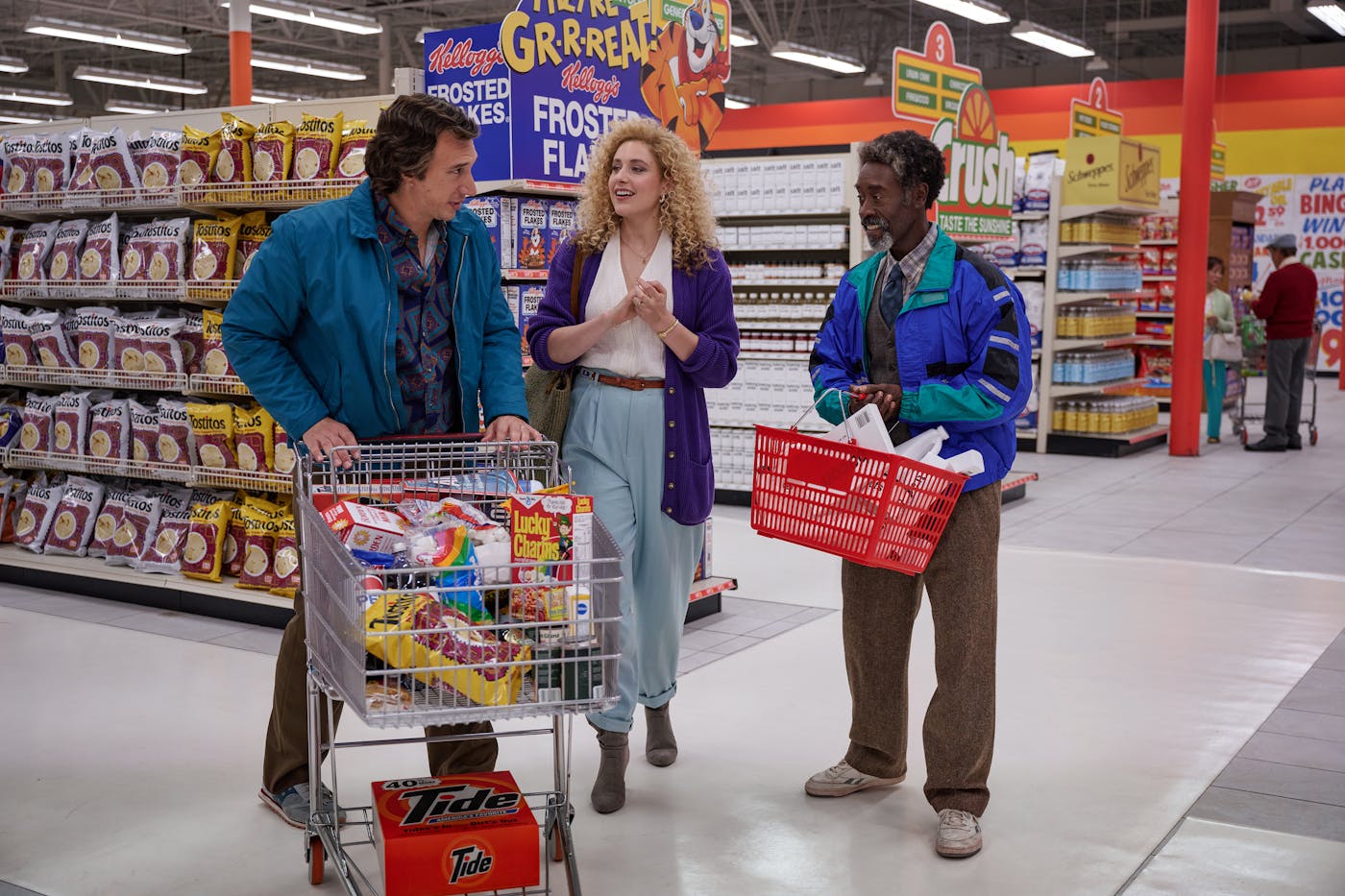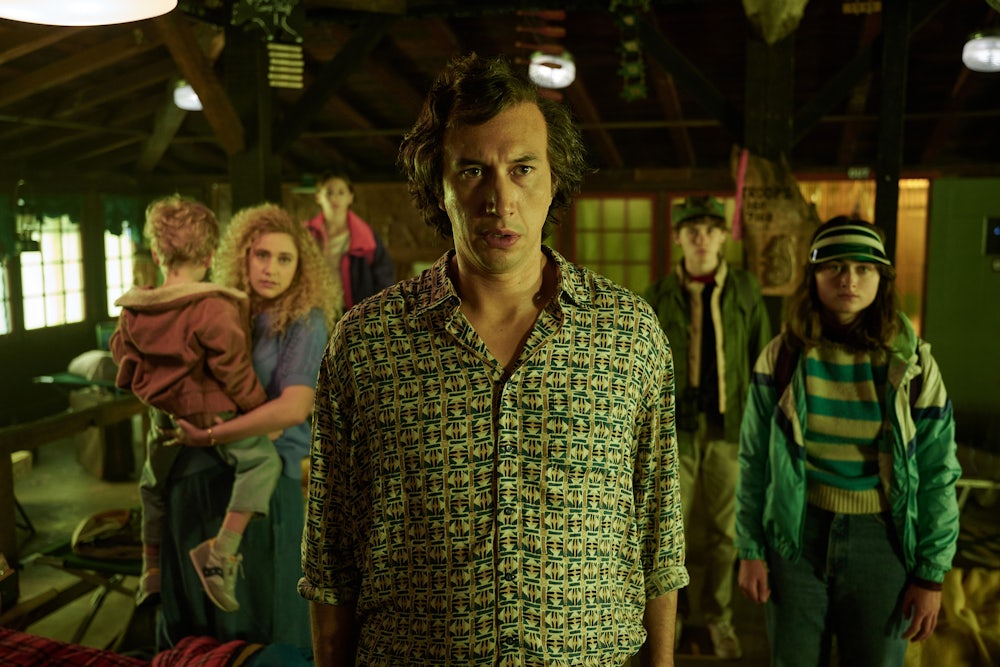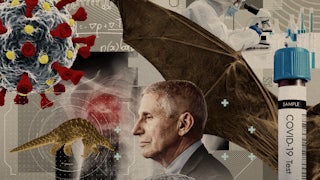Midway through Don DeLillo’s novel White Noise (1985), Jack Gladney, professor of Hitler studies at a generic, brochure-friendly liberal arts college, is about to sit down for dinner when sirens start blaring. Over the radio, there are news reports of a mysterious “black billowing cloud” sweeping the region. Seconds later, the story is updated; it is now an “airborne toxic event.” Jack and his (fourth) wife, the self-medicating, spacey Babette, go on with their meal. They can fathom their own deaths (an obsessive fear they share), but the idea of large-scale collective tragedy is implausible to them. They are, after all, American; disaster is something that happens elsewhere. When their son anxiously repeats the calls to evacuate, Babette stalls: “Did you get the impression they were only making a suggestion or was it a little more mandatory, do you think?”
Now a feature film from indie auteur Noah Baumbach, White Noise has impeccable timing. Just a couple of years out from the onset of a global pandemic, the story’s key elements—an invisible pestilence, ever-changing public health guidelines, mass death as a media spectacle, ambient fascism, the defiled innocence of American exceptionalism—will have viewers coming down with one of the hallmark symptoms of “airborne toxic event” exposure: déjà vu. At one point, at a campsite for evacuees, a character ominously utters, “I saw this before.” Is he sick or does he just recognize this—tents, refugees, chaos—from TV? Perhaps it is a distinction without a difference.
Baumbach’s film is very filmy. He uses his budget, the biggest of his career thus far, to the max—giving us baroque car crash sequences and a visualization of the toxic gas cloud that has echoes of Stranger Things (another Netflix property). The result looks like an assemblage of other movies where bad things happen in the 1980s, a decade that feels like a toxic spill itself, between Reaganomics and Thatcherism.
Baumbach’s White Noise is not political. He has no interest in updating DeLillo’s message of anti-consumerism for a twenty-first–century audience. (If he had, we would probably see Babette and Jack debating what to tip their Instacart shopper rather than walking through the aisles of a supermarket themselves.) Instead, Baumbach feels more interested in pinpointing disaster as a brand, and our addiction to watching it as the closest thing capitalism offers us to a communal experience.
DeLillo’s novel was long considered impossible to adapt. Regarding the unfilmable tag that has hung over the project like a curse, Baumbach has only said: “I don’t even know what that means.” However, the challenges are fairly apparent. First, there is the obvious impossibility of plucking the best lines from a novel where every sentence reads like a straight shot of serotonin. White Noise also contains a mishmash of genres, from academic satire to postapocalyptic disaster movies—thematically similar, maybe, but very different shooting budgets. It is simultaneously a philosophical meditation on death and a laugh-out-loud TV sitcom, replete with a Brady Bunch–esque blended family. That the option rights once belonged to Men in Black director Barry Sonnenfeld, and the adaptation was eventually completed by the man behind Frances Ha, says it all.
But one of the novel’s premises is that Americans can turn anything into television (even Babette teaching posture to senior citizens gets a spot on a local broadcast). From the opening scene, Baumbach prepares us to view White Noise as a meditation on spectatorship. As the movie begins, we are transported to a familiar place: a darkened auditorium where rows of people have gathered to watch a movie being projected onto a screen. A cheery, gray-haired Don Cheadle, as professor Murray Siskind, is delivering a lecture on car crash scenes in American cinema. As clip after clip of automobiles bursting into flames upon impact play behind him, Murray tells his students: “these collisions are part of a long tradition of American optimism.” The American movie director, he continues, is a carrier of a national idea, that we are always striving toward a more perfect union. “Each crash,” Cheadle says, beaming, “is meant to be better than the last.”
Baumbach does his best to live up to this expectation, giving us car chases and crashes for no real reason other than to delight in the way a station wagon looks flying through the air. The station wagon would appear to be Baumbach’s favorite motif from White Noise. The car very neatly encapsulates DeLillo’s critique of American capitalism; in what other moral universe would a wholesome family best be represented by a consumer good? In Baumbach’s film, it mostly exists as a comedic device, as ordinary people play out action scenes they likely saw in movies and TV shows, all the while in their sensible family vehicles. Characters do not leave the evacuation camp so much as burst out of it; now that the coast is clear, they can begin to cosplay the thing they just lived through. Adam Driver, as a frumpy Jack, combines ’80s sitcom dad with ’80s Tom Cruise as he maneuvers, like “Maverick,” through treacherous terrain to find a way to cut through traffic.
Jack has staked his career on the idea that violence is the most durable consumer good: recession-proof, as they say. At the College-on-the-Hill, he teaches classes on “Advanced Nazism,” and his enrollment numbers are like the box-office receipts for a disaster flick. In fact, Jack created the country’s first department of Hitler studies for precisely this reason. He was not acting out of intellectual passion (he does not even speak a word of German); he simply wanted to stake his claim in a field, any field, to cement his status. Everything in America is a product. For Jack, Hitler is like a station wagon—a sound investment. Watching these scenes, one recalls all the news execs circa 2016 saying Donald Trump was “good for business.”
Murray is hoping to find his own sinecure via Elvis studies; “Elvis is my Hitler,” he tells Jack. To help his friend, Jack agrees to a dual lecture, an Elvis/Hitler crossover event to legitimize Murray’s new endeavor. The scene is oddly electrifying: Driver and Cheadle cross-pollinate facts about Hitler and Elvis like an orchestra led by Lydia Tár. It is problematic; it is spellbinding. The students are riveted, as are we—but then, Jack says, so were the Nazis. We are not attracted to spectacle as much as the communal experience of observing a spectacle. “To become a crowd,” Driver’s voice booms, “is to keep out death. To break off from the crowd is to risk death as an individual, to face dying alone.” Very awkward message to project to a crowd of moviegoers, but it is meant to be a provocation. What violences have we committed for no other purpose than to put on a show that we can all attend together? We could ask some 500 migrant workers who built this year’s World Cup stadiums had they not died under the blazing sun.

However, Baumbach is elsewhere too lighthearted when it comes to depicting the herd mentality of the American consumer. One of DeLillo’s working titles for White Noise was The American Book of the Dead. In the novel, death is most neatly symbolized by the American supermarket. We stuff ourselves with food that we claim is life-sustaining but is actually just life-affirming, and then we check out. Baumbach treats the supermarket as an art piece. It is a Technicolor explosion of brand names and tchotchkes; the only thing as bright green as the visors for sale by the cash register are the frozen string beans Babette (Greta Gerwig) buys for dinner. Another director (like David Fincher) might have treated the space cynically or dialed up the dystopia, but Baumbach’s A&P is nostalgia-inducing. Seeing so many familiar brands gave me a sense of satisfaction I did not know what to do with, as if I were experiencing capitalism as a great communal undertaking. Is there not something to be salvaged from the fact that we all want the same things? the film’s label-friendly optimism implies, deliberately or not.
Like the novel, White Noise the film is divided into three parts. The final section is “Dylarama,” in which Jack copes with the potential effects of his exposure to the toxic cloud (he breathed the air while filling his station wagon with gas). The news is grim; he will die—one day. It is a revelation. Meanwhile, it is revealed that Babette has been taking part in a secret study by a shady, perhaps fraudulent lab that claims to have located a part of the brain responsible for the fear of death. Its new drug, Dylar, can turn those receptors off, though there are some grim side effects (half your brain could stop working) and some hilarious ones. As Babette explains to an incredulous Jack, potentially she could lose the ability to “distinguish words from things, so that if someone said ‘speeding bullet,’ I would fall to the floor and take cover.”
Babette’s crisis becomes an opportunity for Jack. He can go and confront one of the Dylar scientists for taking advantage of his wife. The violence, he imagines, might be curative somehow. If he kills, he would be a killer, not a “dier.” Baumbach drapes this scene in “’80s noir.” There is a Blade Runner quality to the dark, rainy sequence—with the neon signs of the motel buzzing against a dismal industrial backdrop. It feels like he is acting out something he has watched before in a movie. We likewise recognize the scene, but cannot pinpoint where. We can tell something bad is going to happen from the smoky motel room, the static on the TV screen. As avid consumers of doom, we are primed to experience déjà vu. Is it a symptom though? Or the disease?
Over lunch, Jack and his colleagues from the popular culture department discuss their TV viewing habits. One of them lists the “mudslides, brush fires, and earthquakes” that he finds so entertaining. They assure themselves that everyone indulges in some kind of doom-viewing, that disaster has a way of drowning out the barrage of useless information we are exposed to in our daily lives, like a white noise machine. “It’s natural, it’s normal, that decent, well-meaning people would find themselves intrigued by catastrophe when they see it on television,” someone says. Indeed, the professors in the popular culture department, who only read cereal boxes, have no trouble making a diagnosis. The affliction in question is Americana 101.
In the end, Baumbach’s White Noise is the most interesting at the formal level, in its assemblage of visual references that point to our appetite for communal consumption of grief and gore. Yet, Baumbach holds back from giving us anything truly bold. The film needed to be far more experimental and political to have something substantial to say about our viewing practices, particularly as screens have become a part our lives in a way DeLillo could not have imagined in the 1980s. That everyone dies alone, but we watch footage of politicians giving PowerPoint presentations on death tolls together, is an observation, but not much more.






